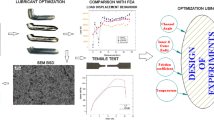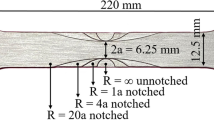Abstract
Titanium alloy extruded profiles with complex cross-section are usually used to manufacture special-shaped structural parts in the aviation industry. In this paper, a Ti-6Al-4 V profile with asymmetric Y shape was manufactured by a direct extrusion process. A comparative study was conducted at the different lubrication conditions, in which the different process deformation mechanisms, resulting microstructures, and mechanical properties of profiles have been investigated by finite element simulation and a series of experiments, i.e., scanning electron microscope (SEM) and electron backscatter diffraction (EBSD). It was revealed that the metal flow is blocked at the narrow die orifice due to the deterioration of lubrication, resulting in the continuous shrinkage defect. The metal deformation coordination mechanism becomes gradually significant due to poor friction contact, which promotes the internal stress in the cross-sectional center to transfer outward to balance the friction at the edge of the orifice, resulting in the reduction of the effective strain in the center. The heat generated by friction weakens the heat exchange behavior between the metal and the die, which helps the profile retain a more uniform temperature field. In the sectional center of the profiles made from the two different lubrications, extrusion with good lubrication results in greater grain/colony refinement due to greater effective strains, and a slightly greater dislocation density was found due to the uniform deformation. The tensile tests revealed that compared with poor lubrication, due to the improvement of Hall–Petch strengthening and dislocation strengthening in the cross-sectional center with good lubrication, the variation range of yield strength and tensile strength is reduced to 11 MPa and 7 MPa, respectively, and the variation range of microhardness is reduced to 44 HV and 32 HV, respectively. The improvement of lubrication not only helps to reduce forming defects but also can obtain uniform mechanical properties.
















Similar content being viewed by others
Availability of data and materials
The raw/processed data required to reproduce these findings cannot be shared at this time as the data also forms part of an ongoing study.
Code availability
Not applicable.
References
Yuan S (2021) Fundamentals and processes of fluid pressure forming technology for complex thin-walled components. Engineering 7(3):358–366
Deng T, Li D, Li X, Ding P, Zhao K (2015) Material characterization, constitutive modeling and validation in hot stretch bending of Ti–6Al–4V profile. Proc Inst Mech Eng Part B J Eng Manuf 230(3):505–516
Zhang C, Li D, Li X, Li Y, Xia Q (2022) High temperature mechanical properties and microstructure evolution of Ti-6Al-4V alloy linear friction welding joints. Machines 10(2)
Guo G, Li D, Li X, Deng T, Wang S (2017) Finite element simulation and process optimization for hot stretch bending of Ti-6Al-4V thin-walled extrusion. Int J Adv Manuf Technol 92(5):1707–1719
Deng T, Li D, Li X, Ding P, Zhao K (2014) Hot stretch bending and creep forming of titanium alloy profile. Procedia Eng 81:1792–1798
Astarita A, Giorleo L, Scherillo F, Squillace A, Ceretti E, Carrino L (2014) Titanium hot stretch forming: experimental and modeling residual stress analysis. Key Eng Mater 611–612:149–161
Zhang Y, Li D, Li X, Liu X, Zhao S, Li Y (2022) Creep deformation and strength evolution mechanisms of a Ti-6Al-4V alloy during stress relaxation at elevated temperatures from elastic to plastic loading. J Mater Sci Technol
Zhang C, Li D, Li X, Li Y (2021) An experimental study of the tension-compression asymmetry of extruded Ti-6.5Al-2Zr-1Mo-1V under quasi-static conditions at high temperature. Metals 11(8)
Jarrah OM, Nazzal MA, Darras BM (2020) Numerical modeling and experiments of friction stir back extrusion of seamless tubes. CIRP J Manuf Sci Technol 31:165–177
Fouad DM, Moataz A, El-Garaihy WH, Salem HG (2019) Numerical and experimental analysis of multi-channel spiral twist extrusion processing of AA5083. Mater Sci Eng A 764:138216
Baffari D, Buffa G, Campanella D, Fratini L, Reynolds AP (2017) Process mechanics in friction stir extrusion of magnesium alloys chips through experiments and numerical simulation. J Manuf Process 29:41–49
Zhou W, Yu J, Lu X, Lin J, Dean TA (2021) A comparative study on deformation mechanisms, microstructures and mechanical properties of wide thin-ribbed sections formed by sideways and forward extrusion. Int J Mach Tools Manuf 168:103771
Sun YD, Chen QR, Sun WJ (2015) Numerical simulation of extrusion process and die structure optimization for a complex magnesium doorframe. Int J Adv Manuf Technol 80(1):495–506
Chen L, Cheng Q, Tang J, Li Z, Zhao G, Zuo Y (2021) Numerical and experimental study on extrusion of ZK60 Mg alloy using billet with temperature gradient. J Market Res 14:3018–3028
Choi B-J, Moon IY, Oh Y-S, Kang S-H, Kim S-J, Jung J, Kim J-H, Kim D-K, Lee HW (2021) Die design for extrusion process of titanium seamless tube using finite element analysis. Metals 11(9)
Matsumoto H, Velay V (2017) Mesoscale modeling of dynamic recrystallization behavior, grain size evolution, dislocation density, processing map characteristic, and room temperature strength of Ti-6Al-4V alloy forged in the (α+β) region. J Alloy Compd 708:404–413
Ma J, Zhang Y, Li J, Cui D, Wang Z, Wang J (2021) Microstructure and mechanical properties of forging-additive hybrid manufactured Ti–6Al–4V alloys. Mater Sci Eng A 811:140984
Chong Y, Bhattacharjee T, Yi J, Zhao S, Tsuji N (2019) Achieving bi-lamellar microstructure with both high tensile strength and large ductility in Ti–6Al–4V alloy by novel thermomechanical processing. Materialia 8:100479
Mirahmadi SJ, Hamedi M (2014) Numerical and experimental investigation of process parameters in non-isothermal forward extrusion of Ti–6Al–4V. Int J Adv Manuf Technol 75(1):33–44
Huang G, Guo X, Han Y, Wang L, Lu W, Zhang D (2016) Effect of extrusion dies angle on the microstructure and properties of (TiB+TiC)/Ti6Al4V in situ titanium matrix composite. Mater Sci Eng A 667:317–325
Nishiyama S, Shirai Y, Fuji K (2016) Mechanical properties of extruded Ti-6Al-4V having acicular α+β microstructure formed in refined α grains. Proceedings of the 13th World Conference on Titanium 581–584
Mueller S, Nitschke R, Gall S (2016) Influence of the forming temperature on the microstructure and mechanical properties of extruded Ti6Al4V Rods. Proceedings of the 13th World Conference on Titanium 235
Turner R, Gebelin JC, Ward RM, Reed RC (2011) Linear friction welding of Ti–6Al–4V: Modelling and validation. Acta Mater 59(10):3792–3803
Seshacharyulu T, Medeiros SC, Frazier WG, Prasad YVRK (2000) Hot working of commercial Ti–6Al–4V with an equiaxed α–β microstructure: materials modeling considerations. Mater Sci Eng A 284(1):184–194
Yu J, Zhao G, Cui W, Chen L, Chen X (2019) Evaluating the welding quality of longitudinal welds in a hollow profile manufactured by porthole die extrusion: Experiments and simulation. J Manuf Process 38:502–515
Ma H, Xu W, Jin BC, Shan D, Nutt SR (2015) Damage evaluation in tube spinnability test with ductile fracture criteria. Int J Mech Sci 100:99–111
Damodaran D, Shivpuri R (2004) Prediction and control of part distortion during the hot extrusion of titanium alloys. J Mater Process Technol 150(1):70–75
Fan J, Li J, Kou H, Hua K, Tang B, Zhang Y (2015) Influence of solution treatment on microstructure and mechanical properties of a near β titanium alloy Ti-7333. Mater Des 83:499–507
Da Costa TJ, Appolaire B, Aeby-Gautier E, Denis S, Bruneseaux F (2006) Modeling of the effect of the β phase deformation on the α phase precipitation in near-β titanium alloys. Acta Mater 54(16):4261–4271
Ma L, Wan M, Li W, Shao J, Han X, Zhang J (2022) On the superplastic deformation mechanisms of near-α TNW700 titanium alloy. J Mater Sci Technol 108:173–185
Guo Y, Britton TB, Wilkinson AJ (2014) Slip band–grain boundary interactions in commercial-purity titanium. Acta Mater 76:1–12
Fan Q, Zhou D, Yang L, Zhou J, Yang S, Yang Y (2018) Study on the oxidation resistance and tribological behavior of glass lubricants used in hot extrusion of commercial purity titanium. Colloids Surf A 559:251–257
Zhu C, Harrington T, Gray GT, Vecchio KS (2018) Dislocation-type evolution in quasi-statically compressed polycrystalline nickel. Acta Mater 155:104–116
Zheng Z, Waheed S, Balint DS, Dunne FPE (2018) Slip transfer across phase boundaries in dual phase titanium alloys and the effect on strain rate sensitivity. Int J Plast 104:23–38
Waheed S, Zheng Z, Balint DS, Dunne FP (2018) Microstructural effects on strain rate and dwell sensitivity in dual-phase titanium alloys. Acta Mater
Wang K, Yan Z, Zhou Y, Wei S, Wang X, Xin R, Liu Q (2020) Slip initiation in interlayered β and corresponding slip transfer during compression of a lamellar-structure titanium alloy. Res Phys 18:103276
Tan C, Sun Q, Xiao L, Zhao Y, Sun J (2017) Slip transmission behavior across α/β interface and strength prediction with a modified rule of mixtures in TC21 titanium alloy. J Alloy Compd 724:112–120
Dang N, Liu L, Maire E, Adrien J, Cazottes S, Xiao W, Ma C, Zhou L (2018) Analysis of shear stress promoting void evolution behavior in an α/β Ti alloy with fully lamellar microstructure. Mater Sci Eng A 737:27–39
Chong Y, Bhattacharjee T, Tsuji N (2019) Bi-lamellar microstructure in Ti–6Al–4V: Microstructure evolution and mechanical properties. Mater Sci Eng A 762:138077
Zhao Z, Chen J, Guo S, Tan H, Lin X, Huang W (2017) Influence of α/β interface phase on the tensile properties of laser cladding deposited Ti–6Al–4V titanium alloy. J Mater Sci Technol 33(7):675–681
Liu H, Zhang Z, Xu K, Zhang J, Xue Y, Wang Q (2021) Evolution of the α phase and microhardness for hot isostatic pressed Ti-6Al-4V alloy during multi-pass deformation. Mater Charact 178:111263
Gao P, Yang H, Fan X, Zhu S (2014) Unified modeling of flow softening and globularization for hot working of two-phase titanium alloy with a lamellar colony microstructure. J Alloy Compd 600:78–83
Wang XX, Zhan M, Gao PF, Zhang HR (2018) Micromechanical behaviour of TA15 alloy cylindrical parts processed by multi-pass flow forming. Mater Sci Eng A 737:328–335
Li D, Huang H, Chen C, Liu S, Liu X, Zhang X, Zhou K (2021) Additive manufacturing of high strength near β titanium alloy Ti-55511 by engineering nanoscale secondary α laths via in-situ heat treatment. Mater Sci Eng A 814:141245
Funding
This work is financially supported by the National Natural Science Foundation of China (No. 51975032 and No.51775023) and Commercial Aircraft Corporation of China (COMAC-SFGS-2020–3227).
Author information
Authors and Affiliations
Corresponding author
Ethics declarations
Ethics approval
Not applicable.
Consent to participate
Not applicable.
Consent for publication
This work is approved by all authors for publication.
Conflict of interest
The authors declare no competing interests.
Additional information
Publisher's Note
Springer Nature remains neutral with regard to jurisdictional claims in published maps and institutional affiliations.
Highlights
• Ti-6Al-4V alloy profile with asymmetric Y shape was manufactured at two lubrication conditions.
• The metal flow velocity at the cross-section tail decreases significantly due to poor frictional contact, resulting in continuous shrinkage defects.
• The microstructure of the cross-sectional center subjected by the low strain field is not refined, and high temperature contributes to the dislocation recovery.
• The coarse colony and low dislocation density caused by nonuniform deformation promote lower yield strength, tensile strength, and microhardness.
Rights and permissions
About this article
Cite this article
Zhang, Y., Li, D., Li, X. et al. Study on nonuniform deformation behavior and mechanical properties of complex-shaped Ti-6Al-4 V extruded profiles with different lubrication conditions. Int J Adv Manuf Technol 121, 5885–5899 (2022). https://doi.org/10.1007/s00170-022-09623-0
Received:
Accepted:
Published:
Issue Date:
DOI: https://doi.org/10.1007/s00170-022-09623-0




